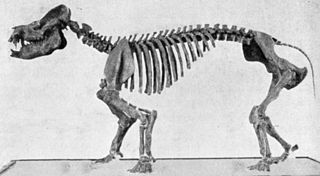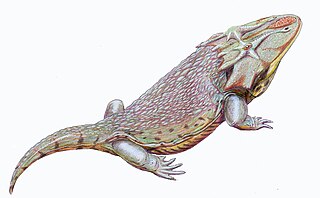
Oxyaenidae is a family of extinct carnivorous placental mammals. Traditionally classified in order Creodonta, this group is now classified in its own order Oxyaenodonta within clade Pan-Carnivora in mirorder Ferae. The group contains four subfamilies comprising fourteen genera. Oxyaenids were the first to appear during the late Paleocene in North America, while smaller radiations of oxyaenids in Europe and Asia occurred during the Eocene.

Dissorophidae is an extinct family of medium-sized temnospondyls that flourished during the late Carboniferous and early Permian periods. The clade is known almost exclusively from North America.

Cionodon is a dubious genus of hadrosaurid dinosaur from the Late Cretaceous. The type species, C. arctatus, was found in the Denver Formation of Lodge Pole Creek, Colorado and was formally described by Edward Drinker Cope in 1874 based on the holotype AMNH 3951, collected in 1873. It is a nomen dubium because it is based on very fragmentary remains. Two other species have since been described: Cionodon kysylkumensis, based on the holotype CCMGE 1/3760 from Uzbekistan, and Cionodon stenopsis, discovered in rocks from the Judith River Formation of Alberta, Canada in 1874. Although both are probably hadrosaurs, they are known only from fragmentary remains and Cionodon kysylkumensis has since been reclassified as Bactrosaurus kysylkumensis.

Coryphodon is an extinct genus of pantodonts of the family Coryphodontidae.

Acheloma is an extinct genus of temnospondyl that lived during the Early Permian. The type species is A. cumminsi.

Sclerocephalus is an extinct genus of temnospondyl amphibian from the lowermost Permian of Germany and Czech Republic with four valid species, including the type species S. haeuseri. It is one of the most completely preserved and most abundant Palaeozoic tetrapods. Sclerocephalus was once thought to be closely related to eryopoid temnospondyls, but it is now thought to be more closely related to archegosauroids. It is the only genus in the family Sclerocephalidae.

Cheliderpeton is an extinct genus of temnospondyl amphibian. It lived during the Early Permian in what is now Europe. Fossils have been found from the Ruprechtice horizon of the Intrasudetic Basin of Bohemia in the Czech Republic, as well as the Saar-Nahe Basin of southwestern Germany. Cheliderpeton had a 16 cm skull, and reached about 65 cm in length.

Dasyceps is an extinct genus of zatracheidid temnospondyl from the early Permian of England.

Zatrachys is an extinct genus of large and flat-headed zatracheidid temnospondyl from the early Permian of North America.

Tillodontia is an extinct suborder of eutherian mammals known from the Early Paleocene to Late Eocene of China, the Late Paleocene to Middle Eocene of North America where they display their maximum species diversity, the Middle Eocene of Pakistan, and the Early Eocene of Europe. Leaving no descendants, they are most closely related to the pantodonts, another extinct group. The tillodonts were medium- to large-sized animals that probably feed on roots and tubers in temperate to subtropical habitats.

Actinodon is an extinct genus of eryopoidean temnospondyl within the family Eryopidae.

Broiliellus is an extinct genus of dissorophoid temnospondyl within the family Dissorophidae. Broiliellus is most closely related to the genus Dissorophus, and both have been placed in the subfamily Dissorophinae. Broiliellus is known from five species from the Early Permian: the type species is Broiliellus texensis, and the other species are Broiliellus brevis,Broiliellus olsoni, Broiliellus arroyoensis, and Broiliellus reiszi. An additional species, Broiliellus novomexicanus, which was originally named Aspidosaurus novomexicanus, is now thought to fall outside the genus as a member of the subfamily Eucacopinae.

Dissorophus (DI-soh-ROH-fus) is an extinct genus of temnospondyl amphibian that lived during the Early Permian Period about 273 million years ago. Its fossils have been found in Texas and in Oklahoma in North America. Its heavy armor and robust build indicate Dissorophus was active on land, similar to other members of the clade Dissorophidae that are known from the Late Carboniferous to the Early Permian periods. Dissorphus is distinguished by its small body size, disproportionately large head and short trunk.

Stegops is an extinct genus of euskelian temnospondyl from the Late Carboniferous of the eastern United States. Fossils are known from the Pennsylvanian coal deposits of Linton, Ohio. It was once classified in the eryopoid family Zatrachydidae because it and other zatrachydids have spikes extending from the margins of its skull, but it is now classified as a dissorophoid that independently evolved spikes. Stegops was first named by American paleontologist Edward Drinker Cope in 1885, with his description of the type species Stegops divaricata. Cope had also named a species of Sauropleura from Linton in 1875, which he called Sauropleura newberryi. This species was later synonymized with Stegops divaricata when the type specimen of S. newberryi was prepared and found to be a large specimen of Stegops.

Madygenerpeton is an extinct genus of chroniosuchid reptiliomorph from the Late Triassic Madygen Formation of Kyrgyzstan. It was first named by paleontologists Rainer R. Schoch, Sebastian Voigt and Michael Buchwitz in 2010 from a nearly complete skull and associated osteoderms. The type species is M. pustulatus.
Parioxys is an extinct genus of temnospondyl amphibian from the Early Permian of Texas.
Nanobamus is an extinct genus of amphibamiform temnospondyl amphibian. The type species is Nanobamus macrorhinus. The type specimen is UCLAVP 3686, a skull recovered from the Lower Permian Arroyo Formation.

The San Jose Formation is an Early Eocene geologic formation in the San Juan Basin of New Mexico and Colorado.

Oxyaeninae is an extinct subfamily of placental mammals from extinct family Oxyaenidae, that lived in Asia, North America and Europe from the late Paleocene to middle Eocene.

Palaeonictinae is an extinct subfamily of placental mammals from extinct family Oxyaenidae, that lived from the late Paleocene to early Eocene of Europe and North America.


















